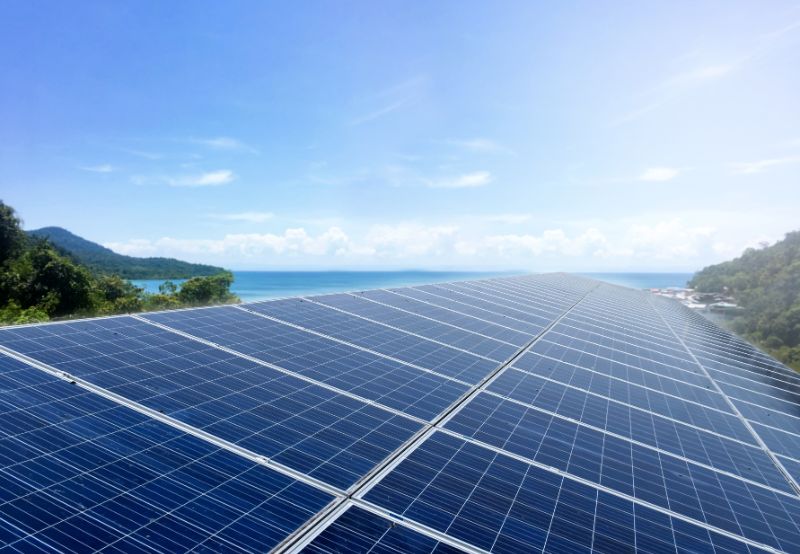Daily News Wrap-Up: Faulty TOPCon Installations Risk Fires
India’s wind energy installations surge 113% in Q2 2025
August 25, 2025
Follow Mercom India on WhatsApp for exclusive updates on clean energy news and insights
The increasing demand for TOPCon bifacial solar modules raised concerns among industry professionals about their potential for unsafe installation, particularly on sheet metal roofs. TOPCon bifacial modules, which are primarily manufactured in glass-to-glass format, are not ideally suited for installation above sheet roofs due to their structural and performance requirements. These modules are designed to capture sunlight from both sides, offering higher system efficiency. However, installing them on opaque, unventilated sheet roofs blocks rear-side exposure to light and traps heat. This limits power generation and significantly increases the risk of overheating and, in extreme cases, fire.
India added 1.6 GW of wind energy capacity in the second quarter (Q2) of 2025, a 113% year-over-year increase from 769 MW in Q2 2024, according to Mercom India Research. Capacity additions fell 13% quarter-over-quarter. Installations declined due to delays in grid connectivity, limited availability of transmission infrastructure, land acquisition challenges, and right-of-way issues. Gujarat led the capacity additions in the quarter with 1.14 GW. Karnataka added 363.6 MW. Of the remaining 134 MW, Tamil Nadu contributed 90 MW, Maharashtra and Andhra Pradesh added 23.1 MW and 20.6 MW, respectively.
If India must install 500 GW of non-fossil fuel-based energy capacity by 2030, the states would require a cumulative grant of ₹140.64 billion (~$1.6 billion) every year over the next five years, according to the National Council of Applied Economic Research. These funds must be devolved to the states by the Finance Commission in the form of green energy grants, considering the potential, installed capacity, and current trend in spending on renewables, it said in a report, ‘Public Financing for Renewable Energy Sector Development: Recommendations for the 16th Finance Commission.’
The City and Industrial Development Corporation of Maharashtra (CIDCO) commissioned a 1 MW rooftop solar project at its Vashi premises to cut power costs and meet its sustainability goals. The installation delivered by Galaxy Solar deployed half-cut mono PERC modules from LONGi and Panasonic (both 550 Wp), coupled with Solis 100 kW string inverters. The system is mounted on a Kalzip standing seam bracket structure fabricated in Al 6063-T6, minimizing roof penetration and ensuring long-term durability. CIDCO had an average monthly energy consumption of 200,000 units.
New Delhi-based waste and wastewater management solutions company Enviro Infra Engineers (EIEL) completed the acquisition of Vento Power, a company developing a 40 MW solar power project in the Bolangir district of Odisha. The total cash consideration for the transaction was ₹1.15 billion (~$13.37 million). The acquisition was carried out through EIE Renewables, a wholly owned subsidiary of EIEL, which has entered into definitive agreements with PTC India. The power generated from Vento’s 40 MW solar project will be sold at a tariff of ₹4.1 (~$0.047)/kWh for an estimated 18 years.
Geothermal capacity can potentially meet up to 15% of the global electricity demand growth by 2050 with continued technological improvements and a reduction in project costs, according to the International Energy Agency’s ‘The Future of Geothermal Energy’ report. The geothermal energy potential is increasing as developers access higher heat resources at greater depths by exploring and utilizing newer technologies. Primarily, two new drilling methods, geothermal systems and advanced geothermal systems, are being explored.
Solar is likely to account for more than half of the 64 GW of new utility-scale electricity that developers plan to bring online in the U.S. this year, according to a survey by the Energy Information Administration. Developers added 12 GW of new utility-scale capacity in the first half of 2025 and plan to add another 21 GW during the second half. Battery storage, wind, and natural gas power plants are expected to account for virtually all of the remaining capacity additions in 2025. Installing 64 GW in 2025 could set a yearly record.
